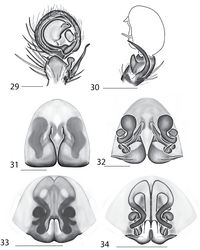Karaops badgeradda
| Notice: | This page is derived from the original publication listed below, whose author(s) should always be credited. Further contributors may edit and improve the content of this page and, consequently, need to be credited as well (see page history). Any assessment of factual correctness requires a careful review of the original article as well as of subsequent contributions.
If you are uncertain whether your planned contribution is correct or not, we suggest that you use the associated discussion page instead of editing the page directly. This page should be cited as follows (rationale):
Citation formats to copy and paste
BibTeX: @article{Crews2011ZooKeys99, RIS/ Endnote: TY - JOUR Wikipedia/ Citizendium: <ref name="Crews2011ZooKeys99">{{Citation See also the citation download page at the journal. |
Ordo: Araneae
Familia: Selenopidae
Genus: Karaops
Name
Karaops badgeradda Crews & Harvey, 2011 sp. n. – Wikispecies link – ZooBank link – Pensoft Profile
Type material
Holotype female (WAM T97214): site 5, Badgeradda Range, Muggon Station, 26°46'01.6"S, 115°32'54.4"E, Western Australia, Australia, 18.III.2009, S.C. Crews, M.C. Murrmann, under rocks.
Other material examined
AUSTRALIA: Western Australia: collected with holotype, 2♀ (WAM T97213, T97215); Muggon Station, site MUG 9, 26°49'03"S, 115°32'56"E, 20–28.X.2003, A. Desmond, M. Cowan, dry pitfall, 1 immature (WAM T95019); Muggon Station, site MUG 5, 26°46'S, 115°33'E, 20–28.X.2003, A. Desmond, M. Cowan, dry pitfall, 2 immatures (WAM T95020).
Etymology
The specific epithet comes from the type locality. The name is to be treated as a noun in apposition.
Diagnosis
This species can be separated from all other species by genitalic characteristics, including a bilobed sclerotized area covering the copulatory openings located in the posterior third of the epigynal plate (Fig. 33). Males unknown.
Remarks
Immatures are matched with this species as they were collected from the same locality as the holotype.
Description
Holotype:Color: carapace yellow-brown, with slightly darker marks laterally and medially; sternum pale yellow; chelicerae pale yellow with darker infuscations anteriorly and laterally; maxillae pale yellow; labium pale yellow-brown, lightening distally; abdomen dorsally reddish with darker red brown cardiac mark, many dark spots medially and laterally; ventrally pale yellow-brown; legs pale yellow, with all segments clearly annulated, though those on femur not entirely encircling it, also hollow in center, giving femora a ‘leopard spot’ appearance. Cephalothorax:setae long and thin; carapace flattened; 0.78 times longer than broad; fovea longitudinal, broad, somewhat shallow. Eyes:AER slightly recurved; PER recurved; PME larger than AME, PLE largest, ALE smallest; eye group width 1.49; eye diameters, AME 0.19, ALE 0.06, PME 0.25, PLE 0.38; interdistances AME-ALE 0.57, PME-PLE 0.33, ALE-PLE 0.38, AME-PME 0.04; ocular quadrangle AME-AME 0.19, PME-PME 0.55; clypeus 0.1 high. Mouthparts:chelicerae with a few stout setae medially and anteriorly; lateral boss present, smooth; promargin with 3 teeth, retromargin with 2 teeth; maxillae longer than broad, with tuft of conspicuous setae distally. Sternum:0.83 times longer than broad, posteriorly indented. Pedipalp:claw present with more than 6 teeth. Legs:leg I much shorter than legs II, III and IV; leg formula 3421; scopulae absent on all legs; tarsus I–IV with strong claw tufts; claws without teeth; spination: leg I, Fm pr 1–1–1, d 1–1–1, rl 0; Ti d 0, v 2–2–2–2–2; Mt v 2–2–2–2; Ti and Mt I and II with strong spines; leg II, Fm pr 0, dorsal 1–1–1, rl 0; Ti v 2–2–2–2–2; Mt v 2–2–2–2; leg III, Fm pr 0, d 1–1–1, rl 0; Ti v 1–1–0; Mt 2–0; leg IV, Fm pr 0, d 1–1–1, rl 0; Ti v 1–0; Mt 0. Abdomen:terminal setal tufts present. Epigyne:lateral lobes fused, small medial depression in lower third of plate, bilobed sclerotized hood, epigynal pockets absent, copulatory openings located under hood; copulatory ducts in contact medially, then both curve outward, then back inward becoming darker and more sclerotized, then outward again before twisting around to the small ovoid, folded spermathecae, fertilization ducts located posteriorly, small posterodorsal fold present, not covering any part of the internal genital (Figs 33–34). Dimensions: Total length 7.33. Cephalothorax length 2.89, width 3.52. Sternum length 1.57, width 1.90. Abdomen length 4.44, width 3.88. Pedipalp: Fm 0.86, Pt 0.46, Ti 0.54, Ta 0.94, (total) 2.80. Leg I: Fm 3.51, Pt 1.29, Ti 2.99, Mt 2.77, Ta 1.20, (total) 11.76. Leg II: Fm 4.44, Pt 1.56, Ti 3.22, Mt 3.08, Ta 1.27, (total) 13.57. Leg III: Fm 4.77, Pt 1.51, Ti 3.73, Mt 3.52, Ta 1.39, (total) 14.92. Leg IV: Fm 4.68, Pt 1.53, Ti 3.44, Mt 3.03, Ta 1.53, (total) 14.21.
Natural history
Collected under rocks (Figs 92, 98).
Distribution
This species is only known from the Muggon Station area of Western Australia (Fig. 98; Map 8).
Original Description
- Crews, S; Harvey, M; 2011: The spider family Selenopidae (Arachnida, Araneae) in Australasia and the Oriental Region ZooKeys, 99: 1-104. doi
Images
|



